D103 Intermediate Filaments (ALS 6, Video 11)
1/29
There's no tags or description
Looks like no tags are added yet.
Name | Mastery | Learn | Test | Matching | Spaced |
|---|
No study sessions yet.
30 Terms
migrating cell contains 2 sets of MTs
golgi apparatus and centrosome
golgi apparatus
additional site of MT nucleation
MTs are directed to the leading edge
function: enhancing vesicular transport to the leading edge
centrosome (MTOC)
primary site of mt nucleation
radial array
function: organelle positioning, vesicular transport routes, mitosis (chromosome segregation)
- end is fixed = no treadmilling
how would you test if golgi-nucleated MTs are more stable than centrosome-nucleated MTs in interphase
tag alpha-tubulin with GFP and perform a FRAP experiment of each MT population
frap could indicate movement and stability
which of these graphs describes the most stable population of microtubules (cells express GFP-tagged alpha-tubulin)?
no recovery
you cannot have recovery if very stable because it cannot freely move
dependent on depol with repol with new mix of gfp tag
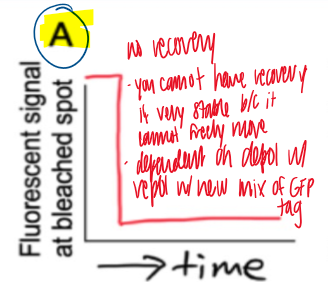

researchers treated cultured human cancer cells with different concentrations of taxol and measured 2 parameters:
percentage of cells in mitosis
average rate of microtubule depol
based on the data, which conclusion best explains how taxol inhibits cancer cell division?
taxol arrests cells in mitosis because MTs are stabilized
what happens to the nuclear lamina during mitosis
disassembles
look for depolymerization and lining of nuc envelope
MTs provide structural support
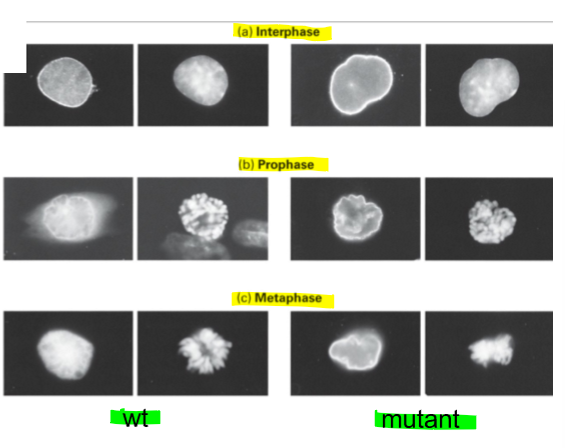
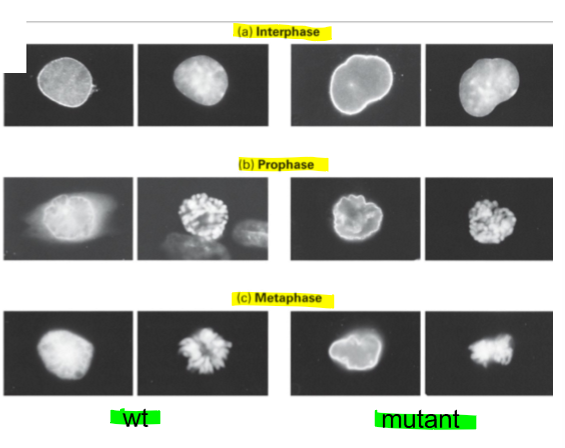
which of the following conclusions is best supported by this experiment
in mutant cells, the nuc lamina does not break down
you now focus on lamin a and its role in nuclear envelope breakdown. the mutation prevents lamin a phosphorylation. which of the following statements best explains your result
lamin a phosphorylation is necessary for NEB
no lam A = no NEB
which is NOT true for primary cilia
they function in moving liquids over a surface
f-actin overview
size: 6 nm
energy for assembly: ATP
energy for disassembly: none
building block: g-actin
polarity in filament: yes
typical features: treadmilling
molecular motor: myosins
one prominent funct: migration
MT overview
size: 25 nm
energy for assembly: GTP
energy for disassembly: none
building block: a/ B-tubulin
polarity in filament: yes
typical features: dynamic instability
molecular motor: kinesins/ dynein
one prominent funct: chromosome seg
intermediate filament overview
size: 10 nm
energy for assembly: no
energy for disassembly: yes, ex - phosphorylation
building block: 70 different kinds of monomers
polarity in filament: monomer and dimer, not others
typical features: sturdy structure
molecular motor: no
one prominent funct: support for epithelial cell layer
functions of intermediate filaments
70 members with diverse cellular functions
provide structural support
plectin, desmoplakin, filaggrin
plectin
links IFs to other cytoskeletal structures
desmoplakin
desmosomes/ cell junction
filaggrin
bundles keratin filaments
intermediate filament monomers
polar
intermediate filament dimer (homo or hetero)
polar because of head-to-head assembly
intermediate filament of staggered tetramer of 2 coiled-coil dimers
anti-parallel = apolar
intermediate filament of 2 tetramers packed together end-to-end
apolar
are intermediate filaments dynamic
yes, must assemble and disassemble to incorporated (dynamic)
assembly occurs independent of energy input
keratin function
provide structural support to epithelial cells
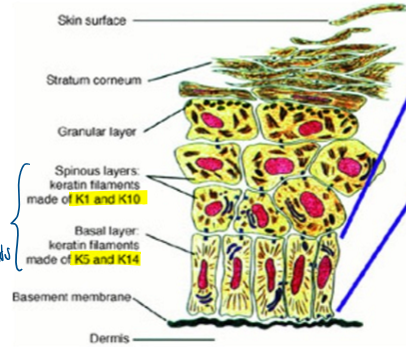
epidermolysis bullosa
keratin mutations
blistering in response to minor injury and inside the skin
caused by mutations in keratin 5 (type II) and keratin 14 (type I)
nuclear lamina function
provides structural support to the nucleus
nuclear lamins form a 2-dimensional meshwork
lamins are nuclear protein and contain nuclear localization signal
the nuclear lamina has at least 4 different roles
dynamic and changes as the cell goes thru the cell cycle
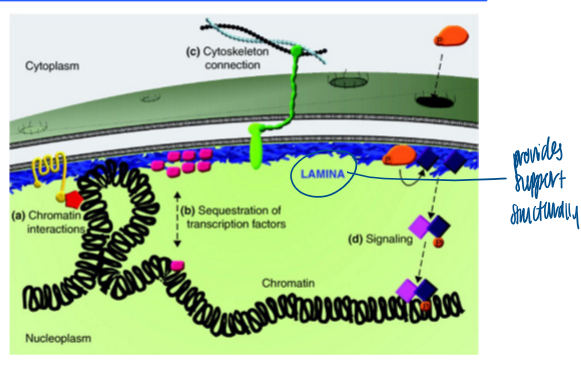
lamin phosphorylation and nuclear envelope breakdown
phosphorylation induces nuclear lamina disassembly, which is necessary for nuclear envelope breakdown
MT and F-actin require energy for assembly, but none for disassembly
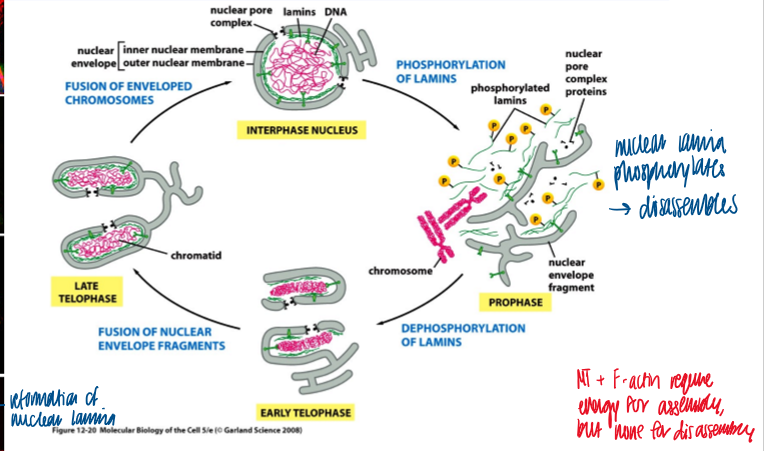
hutchinson-gilford progeria syndrome
mutatiosn in lamin a gene → point mutation prevents heterodimer formation with lamin C → support for nucleus is lost
accelerated aging
intermediate filament overview
tripartite structure
monomer and dimer = polar; higher order = non-polar
dynamic → assembly occurs spontaneously, but energy is required for disassembly (generally thru phosphorylation)
provide structural support to the cell and the nucleus
keratins overview
assembly of keratins is essential for epithelial cell stability, mutations cause severe human diseases
nuclear lamina overview
intermediate filament that supports the nuclear envelope:
disassembles during mitosis
reorganization occurs during the cell cycle
reorganization is induced by lamin phosphorylation
mutations: progeria and muscular dystrophies